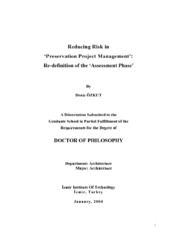Please use this identifier to cite or link to this item:
https://hdl.handle.net/11147/2976| Title: | Reducing risk in 'preservation project management': Re-definition of the 'assessment phase' | Authors: | Özkut, Deniz | Advisors: | Eyüce, Ahmet | Publisher: | Izmir Institute of Technology | Abstract: | The aim of this study is to redefine the pre-assessment phase as a sub-task that is 'pre-requisite' to the implementation and design phases of the preservation project, and to re-construct an effective project framework by emphasizing the role of the risks for the achievement of qualitative objectives. The main goal in constructing the scope of the project and the framework is to attain the synthesis of two different disciplines, namely management science and preservation.Cultural properties have significant 'values' such as having been preserved and transmitted to subsequent generations. Hence the cultural property keeps its originality; it is also required to provide for the preservation of all sorts of valuable architectural elements and values which are indicators of cultural characteristics and historical identity. When observed from a conceptual point of view, 'values' cause the divergences in the preservation process, which are named the pre-requisites in this dissertation.In regard to this dissertation, the preservation process differs from that of a In regard to this dissertation, the preservation process differs from that of a hand, and the legal requisites on the other. The seriously higher ratio of unexpected, unestimated, and unidentified input naturally entails indefiniteness in the preservation process. The most important parameter that shapes a preservation process appears to be 'risks' that consist of those indefinite input preventing the project from a proper definition of its context. The project components that debar scope definition in initial phases of the preservation process increase the risk margin in implementation process as well as intervention decisions and priorities.The Preservation Process is the preservation of the cultural property within an effective project system, which is aimed at attaining the total quality as a result of a synthesis of the technology, technique, and material originally deployed with those of the present. This preservation project, in addition, may be defined as a document that halts the deterioration, exterminates present structural deficiencies, and combines the study, research, evaluation, decision and implementation mechanisms needed to identify the intervention to be performed after research on and identification of the reasons for deterioration of the cultural property are completed.In order to achieve sound preservation, it is essential to obtain comprehensive, accurate, utilizable, and relevant information about the context in the pre-assessment phase, which takes place prior to the projecting phase of the preservation process.The pre-assessment phase is concerned with investigation, analysis, definition, understanding, and solution of the problems that will be the precise input of the priorities. The essential aim of pre-assessment phase is to differentiate the indefinite initial information about the risks in order to prevent the intervention priorities from causing any refractory consequences. Thus, prerequisites of the preservation project will be determinant in forming vertical correlation of project management tools.While approaches offered by the field of preservation occupy center stage in this dissertation, the project management will augment and support the main field.Management of the preservation projects will be in the end attainable for preservation of the cultural identity in a proper way by means of accurate decisions preservation of the cultural identity in a proper way by means of accurate decisions line with the preservation process has been attempted, the more the data of the preservation project will be re-organized and re-defined in order to analyze the risks by means of the utilization of the sub-tasks of Project Management. By means of redefinition of these components with respect to the preservation prerequisites, process of preservation project will be re-organized, as well as re-defined in order to reduce risks, within legal framework.The legal tools, which are the most influential in determining the main framework of the preservation process, are also influential in decision priorities and types of implementation of preservation work. It is primarily required to analyze all legal input including the laws and terms of reference upon which the process of preservation is dependent besides international laws, laws, regulations, by-laws of Higher Council for Preservation of Cultural Natural Entities, notes of the plans, and decisions of sites and groups by Preservation Councils, implementation principles and the unit price lists and material definitions. Those tools that have been classified as constituting the process that precedes the initiation of projecting process, projecting process, the process of approval, and implementation and postpostimplementation processes, have been discussed in terms of their respective impact upon preservation projects and challenges encountered.It is essential to achieve appropriate intervention decisions, priorities and methods of the preservation project with a process chart of pre-assessment phase besides the appropriate implementation depending on these decisions.There will be a main sentence in the chart as, "There may be some re-orientations in the preassessment phase whereas project management tools and preservation process are integrated in terms of defined flexibility". | Description: | Thesis (Doktoral)-İzmir Institute of Technology, Architecture, İzmir, 2004 Includes bibliographical references (leaves: 194-207) Text in English; Abstract: Turkish and English xiii, 207 leaves |
URI: | http://hdl.handle.net/11147/2976 |
| Appears in Collections: | Phd Degree / Doktora |
Files in This Item:
| File | Description | Size | Format | |
|---|---|---|---|---|
| T000272.pdf | DoctoralThesis | 786.14 kB | Adobe PDF |  View/Open |
CORE Recommender
Page view(s)
170
checked on Nov 18, 2024
Download(s)
92
checked on Nov 18, 2024
Google ScholarTM
Check
Items in GCRIS Repository are protected by copyright, with all rights reserved, unless otherwise indicated.